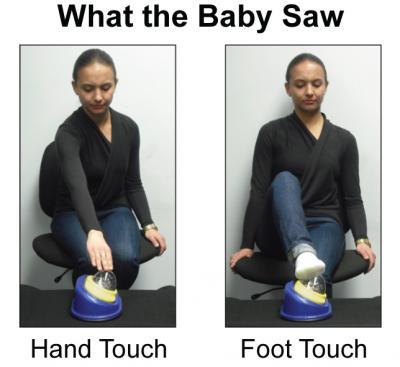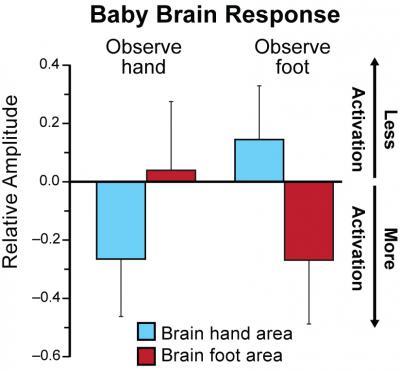Infant brains are surprisingly sensitive to other people's movements, according to new research published October 30th in the open-access journal PLOS ONE, by Joni Saby and colleagues at Temple University and the University of Washington.
When adults see other humans making movements with specific body parts, the parts of their brains devoted to moving those body parts also become activated. While watching someone moving their hand, the part of your cortex devoted to moving your own hand also becomes active. There are various developmental and evolutionary theories as to why this might be the case, one of which being that it might be a neurobiological foundation of our ability to imitate others, which is necessary for cultural learning and language development. Until now, however, this phenomenon has only been observed in adults, and researchers chose to investigate whether the infant brain also shows this sensitivity.
In this study, the authors used non-invasive recordings over the scalp of infants to show that when they observed other people using their hands, activity in the hand areas of their cortex increased. Likewise, when infants observed other people moving their feet, activity in the foot areas of their cortex increased.

These photographs show the experimental setup for the Observe-Hand and Observe-Foot groups.
(Photo Credit: Saby JN, Meltzoff AN, Marshall PJ (2013) Infants' Somatotopic Neural Responses to Seeing Human Actions: I've Got You under My Skin. PLoS ONE 8(10): e77905. doi:10.1371/journal.pone.0077905)
This provides evidence that infant brains are tuned to the mere observation of other people's actions, which offers new clues toward our understanding of imitation and cultural learning. Co-author Andrew Meltzoff expands, "The neural system of babies directly connects them to other people, which jumpstarts imitation and social-emotional connectedness and bonding. Babies look at you and see themselves."

Mean relative amplitude (dB) in the mu band (6𔃇 Hz) during observation of the experimenter (prior to her touching the object). Negative values reflect a reduction in mu rhythm amplitude (desynchronization) and positive values reflect an increase in amplitude (synchronization) relative to a pre-stimulus baseline. Desynchronization patterns significantly varied as a function of experimental group. There was greater reduction in amplitude over the hand areas (C3/C4) for infants who observed hand actions; conversely, there was greater reduction in amplitude over the foot area (Cz) for infants observing foot actions. Error bars represent 1 SEM.
(Photo Credit: Saby JN, Meltzoff AN, Marshall PJ (2013) Infants' Somatotopic Neural Responses to Seeing Human Actions: I've Got You under My Skin. PLoS ONE 8(10): e77905. doi:10.1371/journal.pone.0077905)
Source: Public Library of Science